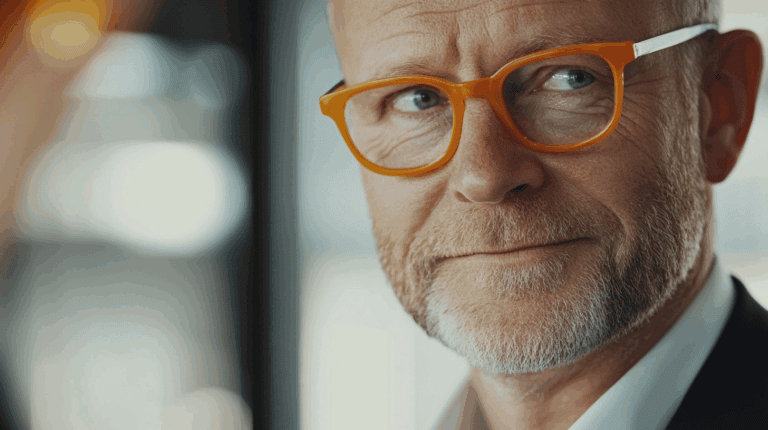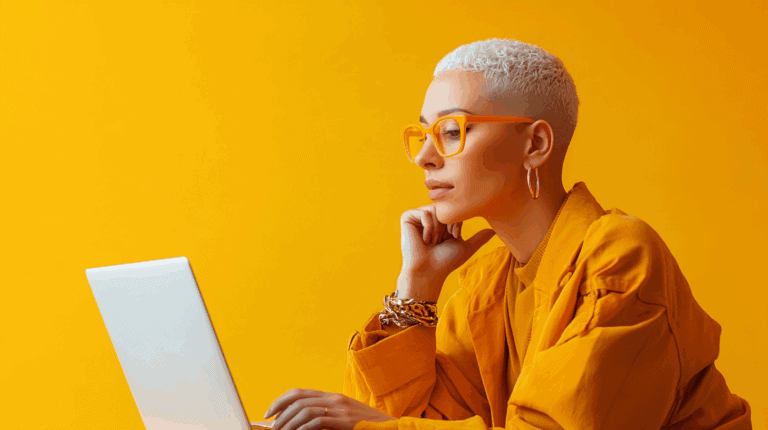How to Master Scroll-Stopping Visual Content for B2B Social Media Marketing
Picture this: you’re catching up with some colleagues over lunch, politely nodding along with one’s lengthy discourse on market trends. Their insights could be fascinating – maybe even actionable – but their delivery is about as engaging as a paperclip.
You’re fighting a losing battle with a yawn when you notice a group gathered around looking at the new intern’s phone. Excusing yourself and wandering over, you see that he’s showing a video of his cat swatting things off his desk.
As the group chuckles, the intern mentions the ergonomic computer chair at the centre of his setup – and the wonders it’s done for his productivity. Before you know it, you’ve got your phone out, looking up the product specs and reviews. You suspect that later, your thumb will be hovering over an “Order” button.
Okay – B2B decision-making is a bit more complicated than that. But as B2B marketers, we often forget that captivating content is as much about your presentation as the story you tell. And if your business goal is to increase sales, it’ll take more than stock images to connect with customers.
Sign up for our newsletter
Get the latest news and ideas from 1827 Marketing sent directly to your in-box.
You will receive an email from us every couple of months, and you can opt out at any time.
Mastering the art (and science) of thumb-stopping visuals transforms how large and small businesses communicate with clients. Visually robust social media marketing strategies can significantly enhance engagement by capturing the attention of audiences stretched to the breaking point by modern media saturation .
The Power of Visual Storytelling in B2B
We often think of B2B transactions as dry or purely transactional, but as we’ve said before, business decision-makers are human – making emotions as much a driving force in B2B buying decisions as for consumers choosing a new sofa. Compelling visual storytelling exudes authenticity and fosters human connection in a way that words alone cannot.
It can also distill complex data and abstract concepts into digestible, easy-to-understand formats. I nfographics effectively and engagingly summarise a detailed market analysis or delineate the impact of a service on ROI when an article presenting the same information might leave readers cross-eyed. You can even dress up key quotes within the infographic to enhance their visual appeal. Explainer videos become shoppable product demonstrations, digging into nuances of a service that would otherwise make for a lengthy read in a text-based post or blog entry.
If you think having a Baby Boomer-heavy target audience means you can skimp on a social media marketing plan and visuals, think again. No matter their generation, your target audience is active on one of the leading social media platforms, where visuals utterly dominate the experience.
Offer Boomers brand interaction on Facebook and YouTube, and feed Gen X’ers innovative content on TikTok, where they’re the fastest-growing generation of users. Millennials are social media natives who value community and won’t engage with cookie-cutter content. Gen Z’ers are highly active across all platforms, especially LinkedIn, given that many are just starting their careers.

Consistency and Branding in Visuals
Every visual element in your marketing materials is an opportunity to enrich and reinforce your brand. Even your colour and typography choices will evoke subtle associations and emotions in viewers, so don’t take these decisions lightly. In many cases, your visual identity is a customer’s first introduction to your brand, and you only get one chance to make a first impression.
B2B sales cycles can be long and complex, and staying top-of-mind can be the difference-maker in securing a win. Using the same colours, fonts, and style cues across your messaging helps audiences form a strong association with your brand, easing the process of recognition and recall when a business need arises.
A consistent visual style also subtly assures B2B decision-makers that you have your organisational ducks in a row. Inconsistency creates confusion and a perception of disorganisation or unreliability.
Adapting to Platform-Specific Visual Norms
While maintaining brand consistency across platforms is crucial, you must also adapt your visual language to align with the presentation style your target audience expects on each platform.
Rather than just repurposing content across platforms, analyse what types of visuals gain traction and engagement based on each platform’s culture. Then adapt accordingly while staying true to your brand identity through logo, color scheme, voice etc.
For example, LinkedIn’s professional audience responds to polished visuals like high-quality photos, infographics, and slide decks formatted to fit seamlessly in the feed. Webinar recordings and podcast snippets can also play well. LinkedIn will autoplay up to ten minutes of native video uploads in-feed and offers 30-minute, targeted video ads .
YouTube viewers expect high production value, with HD video and attention to lighting, audio, editing and more based on content type. Thumbnails with catchy text and colour pop attract more clicks. Given YouTube’s status as second only to Google in search volume, paying attention to growing your presence there could broaden your brand’s reach exponentially.
However, not all platforms are about corporate polish and high production values. On TikTok and Instagram, authentic behind-the-scenes footage, react videos and meme references resonate. You’ll need to balance your professional veneer while hewing closer to these platforms’ inherently informal tone, but if Deloitte and IBM can do it, so can you.
For instance, a software company could humanise its brand and lend authenticity to its messaging by leveraging Instagram’s Stories and Reels to share day-in-the-life clips, visually engaging graphics, and product demos (lighthearted gaffes and outtakes welcome).
Regardless of whether you think ‘influencer’ is a real job, these super-users have mastered the ins and outs of their preferred platforms’ unique visual language. Partnering with the right one can get your brand in front of their followers and instantly boost your credibility.

Cut Through the Noise with Arresting Visuals
We’ve gathered some suggestions for creating visuals that can set your brand apart. This list is not exhaustive – instead, we hope it inspires you to come up with even better ideas of your own.
Balance Consistency With Timely Aesthetic Shifts
“If you’re not meaningfully engaging with culture, which is always in flux, you’re going to fall behind,” says Leo Porto, founder and creative director of the New York-based design and branding agency PORTO ROCHA. The advice may seem paradoxical, given the importance of maintaining brand consistency.
Some shifts are more timeless and B2B friendly than others. Showcasing real, diverse people and their work environments for more authentic marketing is less of a trend than a long overdue shift. And it will be easier to adapt your branding to incorporate an ‘explosive gradient’ or more on-trend minimal infographics and simple layouts than ‘holographic surrealism’ or ‘Y2K Aesthetics’.
The point isn’t to respond to every trend. Instead, B2B marketers should identify trends that complement rather than overshadow the brand’s core identity and strive to maintain consistent brand messaging regardless of aesthetic changes.
Leverage Motion to Capture Attention
Moving elements naturally stand out to the human eye. They hijack our hardwired, movement-attuned survival instincts to prompt users to pause their scrolling and pay attention.
GIF and memes aren’t going anywhere and have made their way into more informal B2B formats. They are budget-friendly and are ideal for short, punchy messaging (or humanising your brand with a bit of self-aware humour).
High-quality video productions and animations will still have a place, given their ability to tell in-depth stories, develop comprehensive brand narratives, and professionally showcase product features. However, you don’t have to be Steven Speilberg to make a significant impact with video. YouTube, LinkedIn, and Instagram stories and reels can all enable you to test the waters.
“Going live” can also lend a sense of immediacy to your content, paving the way for you to make a splash with a big announcement. Live video also has a knack for generating FOMO – fear of missing out – and spurring conversations as people rush to share the feed with others.
Hook Viewers Fast With Vertical Video
Popularised by TikTok and Instagram Reels, short-form video content is characterised by a portrait orientation and dynamic visuals. But don’t worry – you don’t need to master the latest dance to get your point across.
This format leads in with a strong hook and focuses on a singular message or idea. It’s also popular for teasing big news or announcements. Short-form content creators frequently use on-screen captions to deliver and emphasise essential information, ensuring users watching on mute don’t miss the message.
Snackable videos are powerful engagement drivers that cater directly to online audiences’ insatiable appetite for quick-fire snippets of entertainment and information. If you want proof of the format’s viability in 2024, consider the increasing prominence of Shorts content on YouTube.
Ephemeral content, like Instagram Stories, straddles the worlds of snackable content and full-on videos. If you’re looking to dabble in short-form video creation, sharing snippets of longer-form videos can be a great way to repurpose old content while gaining experience in a new format. Serialising your ephemeral content can prolong audiences’ engagement and help you reach people who use social platforms in different ways.
Layer In Visual Cues that Prompt Participation
“Interactive” doesn’t necessarily mean “complex.”
Simple interactive elements, like photo carousels, can significantly enhance the visual storytelling experience. These elements invite users to actively participate, creating a dynamic visual journey as they scroll through images, much like turning pages in a book.
Incorporating interactive elements into Instagram Stories, such as polls and questions, can also add a layer of visual appeal. These features not only encourage audience engagement but also provide visual cues and prompts that make your content more engaging and memorable.
We also expect interactive video use to grow in 2024 as marketers enable viewers to actively engage with the content and make choices about what they see. By integrating elements that require viewer input, these videos transform from passive content to an immersive visual journey. With a Google Analytics hookup, interactive videos offer the dual benefit of ensuring viewers get relevant content while you gather data insights that can help develop future content.
Curate Authentic Client Stories Beyond Quotes and Testimonials
Also known as UGC, user-generated content can be the ultimate combination of storytelling and authenticity – two vital strategies for B2B marketers looking to break through the social media noise in 2024 and beyond.
Encouraging clients to share their experiences with your products and services through photos or videos adds a layer of credibility that other marketing materials typically lack.
When considering how to work with users, consider how you can get content that goes beyond ‘talking-head’ videos. You might be able to curate mini-documentaries that tell ‘client spotlight’ stories or ‘innovation in action’ guides that showcase your product or service in action. ‘Before-and-after’ sequences can showcase the transformation and impact of your solutions in a visually compelling manner.
Consider Your Users’ Context to Thoughtfully Guide Experiences
Making content inclusive isn’t just be about ensuring differently-abled audiences can access your message. A commitment to inclusivity also sends a powerful signal about your brand’s dedication to customer service.
Including alt text with images allows users with visual impairments to have the description read to them by screen reading technology. You can offer high-contrast colour options for people with low vision as well as colour choices that support your colour-blind customers.
Adding subtitles to videos is a must for people who are hard of hearing. But it can also make social content accessible for people who can’t turn up the sound on their devices. Make sure to double-check and edit auto-generated captions, which can be hit-and-miss. Failing to do so looks unprofessional and can make your content unintelligible for people who rely on captions.
No matter the medium, consider remaking your content in several formats to broaden its accessibility. For example, don’t just post an idea once as a static image with a text description; consider how you can repurpose it as a carousel, and as a snackable video with audio.
Reinvigorate Your Social Media Visuals with 1827 Marketing
Remember: without a vivid, engaging presentation, social media users will scroll by even the most substantive content. Mastering the techniques and concepts above can transform your visual content strategy and help you create meaningful connections that resonate deeply with your B2B audience on social media platforms.
Want some expert guidance putting these social media marketing strategies to work? We’d love to chat about how the 1827 Marketing team can help you leverage scroll-stopping visuals to become a serious player on customers’ most-used social media channels.
Have a B2B marketing project in mind?
We might be just what you’re looking for






